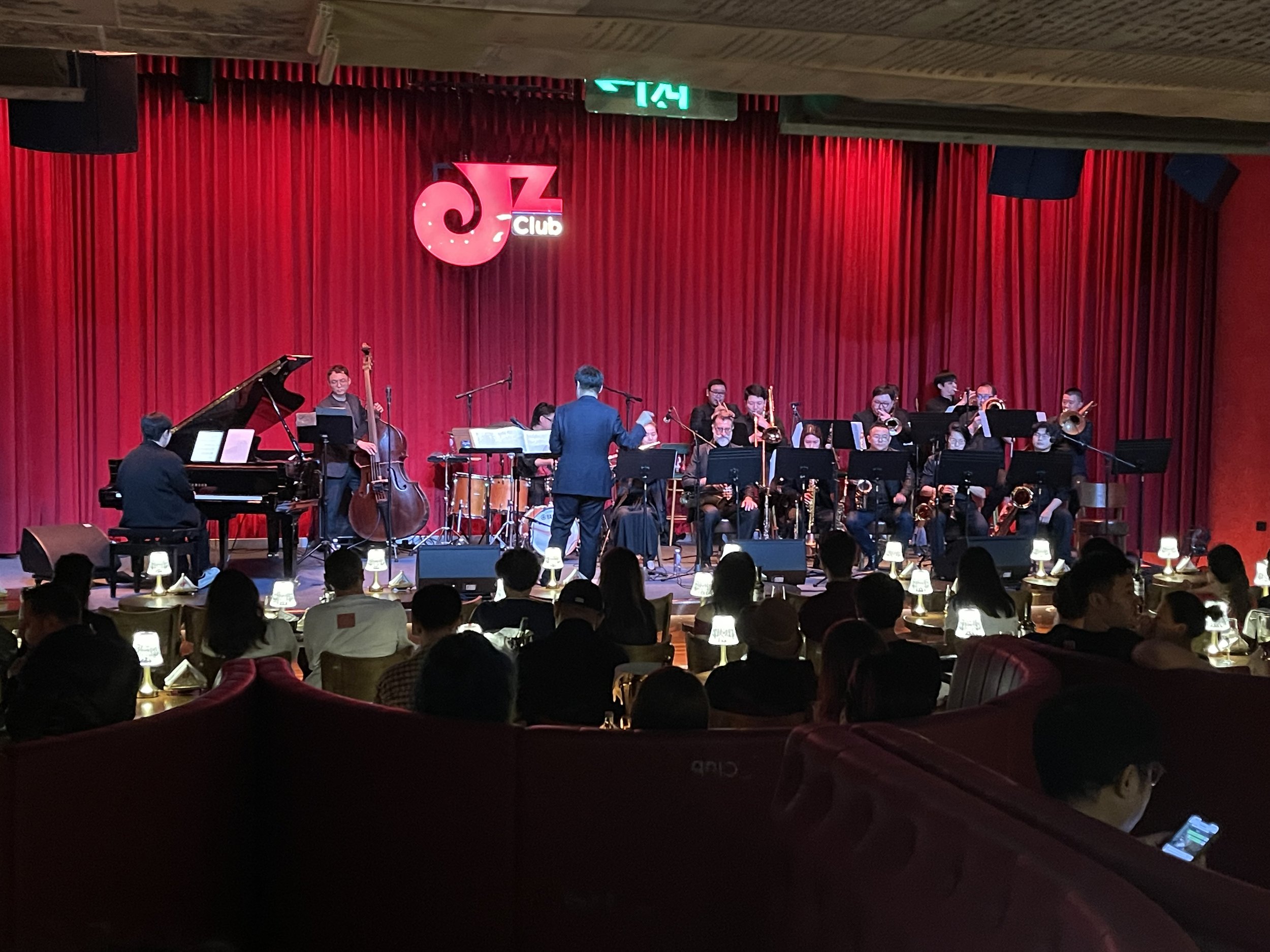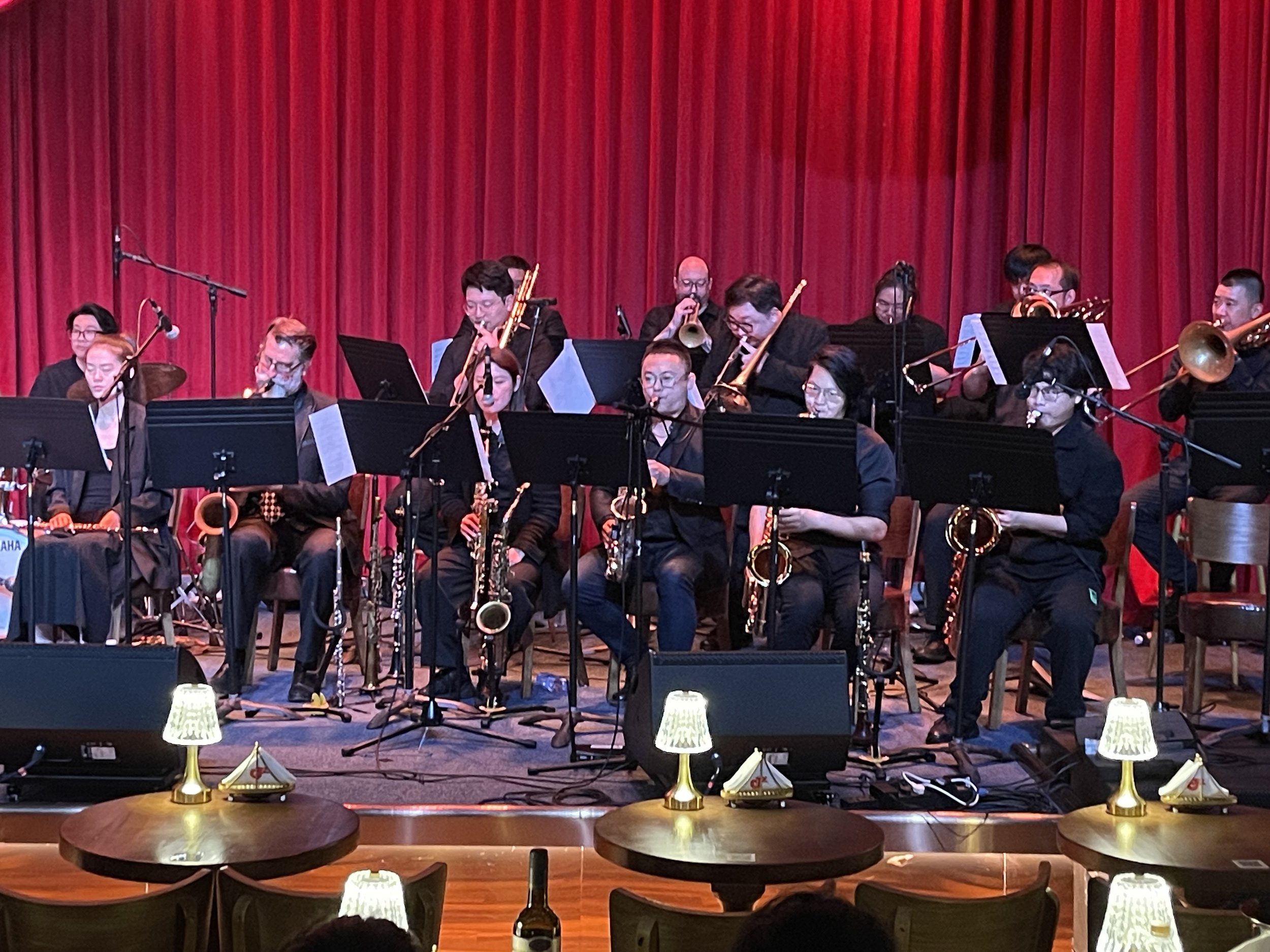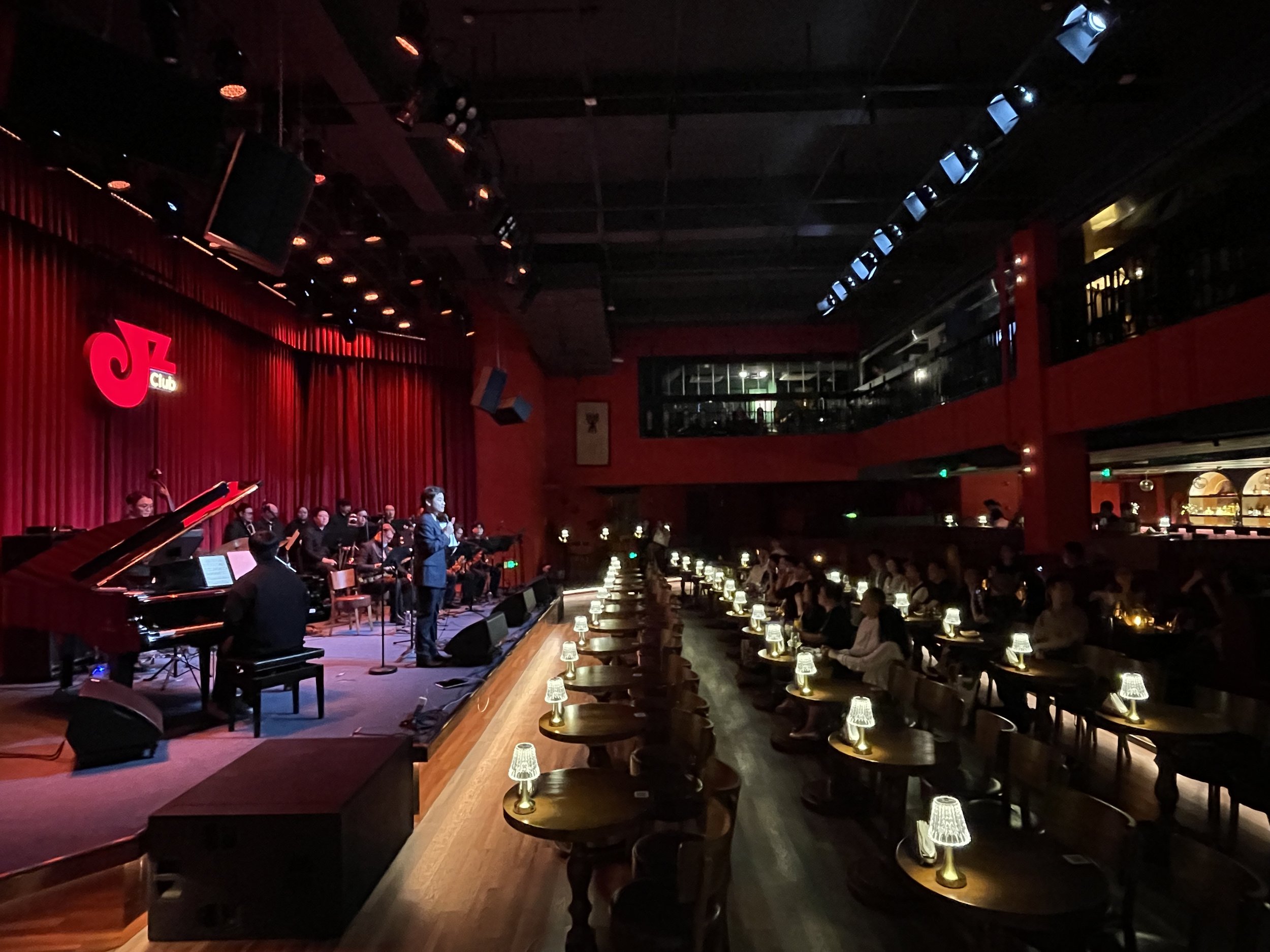(I admit I’ve been quite derelict in not keeping up with posting on my website. There are reasons for this dereliction, though I’m not sure exactly what they are. Suffice it to say I have been in a bit of a writing slump lately, but the first step to the cure is to admit the problem. The second step is to start writing again.)
Last night I joined around 20 DKU students at the JZ Club in Shanghai. I had organized this special “field trip” along with our Jazz Club president Jesse Campbell. We met at the club around 7 pm to see the JZ Big Band perform a set of arrangements by conductor Gary Wang (Wang Kaiji). Throughout the performance, the conductor and arranger interspersed the songs with lengthy explanations of them in Chinese. The majority of guests were Chinese so I suppose that made sense, though it might have been nice to have a few brief summaries in English for the non-Chinese-speaking customers. Nevertheless, it was a fine mixture of music and musical education for the audience. Many of the customers brought their spouses, friends, and families, and there were many children in the audience.
Our “field trip” group of Duke Kunshan University students, sponsored by the Jazz Club. Club president Jesse Campbell is just below Nick Xue posing with Alec Haavik in the back.
I will not belabor the reader with lengthy descriptions of the pieces and their arrangements. Instead, I’ll just describe them as long, grand, intricate, winding, full of delicious inuendoes. These were smoothly satisfying compositions that blended all the instruments together into a mélange of melodies, ideas, and textures while giving plenty of soloists a chance to soar above the orchestra. The 20-piece band represented the A-list of Shanghai jazz musicians, including a piano player on a Yamaha Grand piano, an upright bass player and a drummer, a trumpet section, a trombone section, a saxophone section, and other reed players including a flutist. You can find their names on the poster promoting the event:
A closer view of the horn section with trumpets, trombones, sax and other reeds
Now I would like to share some of my own impressions of the scene and the setting, and how the music made me feel over the course of the evening concert.
Arriving at the venue by Didi (China’s equivalent to Uber), I found myself in a new restaurant and bar zone called No. 8. The JZ Club recently moved from its previous location in the subterranean zone known as Found 158 to this present location. This was my first experience with the new JZ Club. To find it, you walk down a narrow pathway off of Hengshan Road, not far from the corner of Wulumuqi Road. You stroll past the main bar and restaurant area of the No. 8 Zone, following the beacon of the red JZ sign. The entrance to the club is very modest and a bit mysterious. It leads underground down a set of stairs to the club two floors below.
The modest club entrance off of Hengshan Road
The main hall of the club is cavernous with a high ceiling. The club is decorated in red with red lighting and red curtains. The stage is large and in front of the stage is a large polished wooden floor area filled with small round tables lit by LED lamps. There are semi-circular sofa seating areas behind the tables, and then up a level is the bar at the back of the room. On the two wings are elevated spaces for people to sit as well. All the seating is arranged by ticket price. For the lower price of our tickets, we took the area in the wings. The high barstools we sat upon weren’t too comfortable, and I had to get up and stretch now and then, but we certainly had a good view, if an oblique one, of the stage. During the show I went around and took photos from different angles. There is no spot in the club that doesn’t afford a good view of the stage. The sound quality is good as well, and unlike the previous venue there are no loud neighbors to disturb the performances (in the Found 158 venue, you could hear the boom-boom of nearby discos reverberating through the walls).
Even though the new venue works well as a performance space, highlighting the excellent musical talents of the Shanghai jazz scene, it doesn’t feel quite as cozy as the two previous venues. The now legendary club on Fuxing Road and the previous one in Found 158 felt more like comfy hangouts where it was as much about sociability and meeting cool cats in the scene as it was about the music itself. In the new JZ Club, the music seems to be the highlight, and socializing has taken a back seat. At least that was my impression of the new space. It feels too cavernous for an intimate jazz lounge and designed more as a performance theater. I will have to come back again perhaps later in the evening to see if the social environment of the previous JZ still thrives.
All in all, I think it was a wise decision for the club to move out of Found 158, which had become a kind of “foreigners’ ghetto” over the years with its rowdy beer halls and restaurant bars and discos (though since the pandemic, most of the customers are now Chinese). The new location on Hengshan Road is far more elegant and befitting of the upscale vibe that the club wishes to project, even if the No. 8 Zone hasn’t quite caught on yet with the fashionable Shanghai crowd. And the space is far more protected from errant sounds. Certainly, the new JZ Club succeeds as a performance venue.
Alec Haavik taking a solo
Highlights of the evening included solo performances by bandleader and lead tenor sax player Alec Haavik, as well as lead trumpet player Jeremy Sinclair, two of the finest foreign fixtures of the Shanghai jazz scene. Solos by sax players Nick Xue, Huang Ye, and others rounded out the evening, and we even enjoyed a few piano, bass and drum solos. (I’d have to go back into my recording of the evening’s performance to analyze the performance any further.) After the final song of the evening, the band was encouraged to do a lively encore of more old-style jazz which gave many players a chance to do one more groovy solo.
Throughout the performance I was thinking about what a shame it is that jazz has become almost completely separated from the dancing that characterized the great Jazz Age of the 1920s-1930s. If this band had been swinging these tunes in that era, the floor would have been full of dancers decked out in their finest tuxedos and ballroom gowns, swishing away and switching partners on the floor. Now everybody sits quietly and compliantly in their seats, watching the band (though I noticed a lot of the guests were constantly on their phones or else using them to video the show). Back then, people entered a social scene and took risks, showing off their dancing and their social skills and helping to create the scene. I feel that our present world is far more passive and flaccid in comparison, and though I take pains not to glorify the old days (especially in Shanghai during a violent era of famine, disease, revolution, and war) I feel we’ve lost a big piece of our collective humanity.
A broad view of the stage and main floor from the wings
Some of our students also remarked on how the new place (like so many clubs today) is set up to maximize potential profits with tables clustered up to the stage, not allowing much if any room for dancing or socializing on the main floor. In this sense it operates more as a restaurant or fixed-seat theater. I know there are times when they change the arrangement to accommodate dancers, particularly on the swing dance nights that Alec and his band the Shindiggers lead, and I should go and attend one of those events to see how it goes. But while listening to the epic sweep of the jazz orchestra last night, I did feel a sense of yearning, a nostalgia for a lost era of elegance, decadence, bravery, and risk-taking. Someday we will all mourn the loss of the Dancing Age. True, there are other clubs where you can go that feature dancing (though the dance floors have shrunk a great deal since the dance-crazy age of the 1990s), but wouldn’t it be nice to have more of it at the JZ and other jazz clubs?






